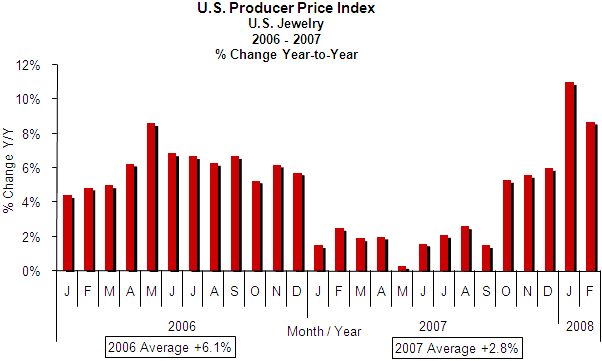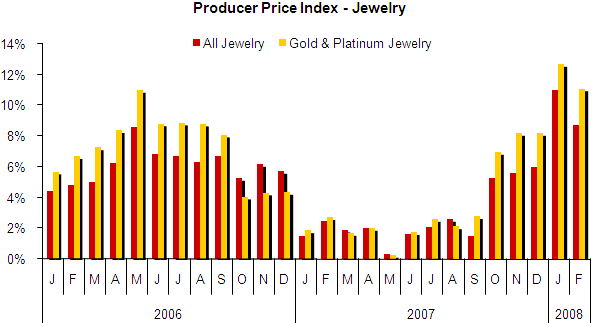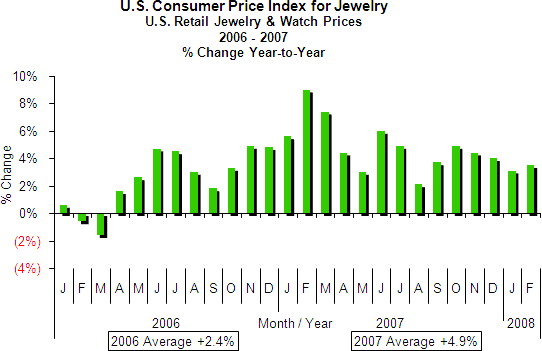IDEX Online Research: Jewelry Producer Prices Continue to Surge, but Retailers Aren’t Passing the Cost
March 24, 08
What’s wrong with this picture? Each month, U.S. jewelry wholesale prices rise, often sharply (they were up 8.7 percent in February, after rising by 11.0 percent in January). But jewelry retail prices continue to show only moderate inflation (they were up 3.5 percent in February, after rising by 3.1 percent in January).
What are some of the possible conclusions?
1) Jewelers enjoy seeing their margins evaporate like water in the desert.
2) Jewelers think they can’t raise their prices because they might make someone mad or scare off customers.
3) Jewelers don’t know just how badly inflation is robbing them of their profits because they don’t have adequate financial systems. (Translation: a variation of “they know not that they know not.”)
We guess that there are some other more sinister scenarios that jewelers implement when margins get squeezed - under-karating, reducing the weight of goods, finding a lenient grading lab to provide diamond certs… Banish those thoughts!
Worse, with the current economic environment, demand for jewelry has softened. So, jewelers must contend with both lower margins and reduced gross profit dollars as a result of lack of sales growth. How can these merchants cover steadily rising relatively fixed costs and remain in business?
The answer is, of course: they won’t remain in business.
To be fair, a few jewelers have announced that they are re-pricing their goods (that’s code language for “raising retail prices”) beginning this spring, after the Valentine’s selling season. We have jewelry industry inflation data only through February. So, perhaps the jewelry retail pricing inflation figures will reflect this re-pricing in subsequent months. In the meantime, though, margins are being squeezed.
For those jewelers who see the urgency of the situation and plan to do something about it, you are very smart: you’ll likely be in business this time next year. And, even better news: you’ll have fewer competitors to contend with.
Already, we’ve begun to see high profile retail jewelry bankruptcies such as Friedman’s and Fortunoff. The Jewelers Board of Trade reports that the average collection claim by its manufacturing members against retail jewelers is climbing, though the number of jeweler bankruptcies remains within the historical range. Based on history, jewelry bankruptcies are expected to begin to rise later this year, with a notably large number occurring in early 2009, just after the 2008 Holiday Selling Season, assuming that the economic cycle follows a historic progression.
The outlook for further price increases is clear: recession or not, neither suppliers nor retailers can afford to continue to live with declining margins. Consensus forecasts call for continued high precious metals prices, while overall diamond prices remain stable, with a modest upward bias. Thus, cost pressures will remain throughout the jewelry pipeline for the foreseeable future.
February 2008 – Jewelry Price Inflation Rises
- Jewelry Producer Price Index (JPPI) +8.7 percent in February – U.S. jewelry producer prices surged by 8.7 percent in February 2008, according to the Bureau of Labor Statistics (BLS). Suppliers can no longer cope with steadily rising costs without passing the full brunt of those increases along to their customers. Most suppliers’ margins are much smaller than retailers; they simply don’t have the profit cushion to continue absorbing higher costs. There were broad hints in the JPPI during the final quarter of 2007 that this surge was materializing. After nine months of modest supplier price increases in 2007, the JPPI jumped substantially in the fourth quarter of 2007, and leaped in January. This year’s JPPI surge is not a statistical aberration; it is real.
- Jewelry Consumer Price Index (JCPI) +3.5 percent in February – U.S. jewelry consumer prices rose by 3.5 percent in February, as calculated by the BLS. This is the calm before the storm, in our opinion. Many jewelers are expected to follow the lead of Sterling and Zale, both of whom have announced that they will selectively raise their prices this spring. By the end of the second quarter, it is likely that we will see an upper single-digit inflation rate for the retail jewelry segment of the industry.
Jewelry Producer Price Inflation Surges in February
Jewelry producer prices surged by 8.7 percent in February 2008. This sharp jump in the jewelry producer inflation rate was due to two factors: 1) rising prices of most commodities used in jewelry manufacturing; and 2) an 11.1 percent increase in the price of gold and platinum jewelry, of a major component of the JPPI. While February JPPI moderated from January’s near record of +11.0 percent, it is a harbinger for prices this year, in our opinion.
Inflation rate comparisons in February were relatively easy against last year’s 2.5 percent gain in the JPPI for February 2007; for the full 2007 year, the JPPI was up 2.8 percent. It is clear that this year’s supplier price increases are very real, and driven by higher component costs, rather than a trick of math.
 Source: BLS |
As mentioned earlier, inflation at the jewelry producer level was driven largely by rising precious metals costs, as the graph below illustrates. The red bars represent JPPI; the gold bars represent JPPI for precious metals components – primarily gold and platinum.
 Source: BLS |
Jewelry Consumer Prices Rise Only Modestly in February
Last year, retail prices of jewelry in the U.S. market rose by 4.9 percent. So far this year, they are running well below that average rate – +3.1 percent in January and +3.5 percent in February. But this is just the calm before the storm, in our opinion. Most jewelers had been hesitant to raise prices in front of the Valentine’s selling period, especially since demand has been soft for the past few months. Further, economists are calling for a recession in 2008, and no jeweler wants to raise prices and scare off customers. Unfortunately, there really isn’t much price elasticity related to demand at the retail level in a recessionary environment. Shoppers are already in a mental recession, and no level of price concessions – short of giving goods away – is going to create significant store traffic and demand. If anything, this is a good time to raise prices. When the economy recovers, retailers will have their new prices in place, and consumers won’t know the difference.
The graph below summarizes the percentage change in retail prices of jewelry and watches by month on a year-to-year basis since 2006. The percentage change is based on a comparison to the same month a year ago.
 Source: BLS |
Outlook: Higher Prices on the Horizon